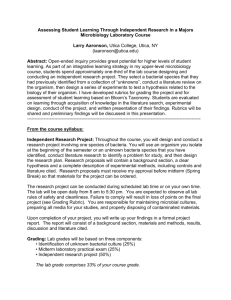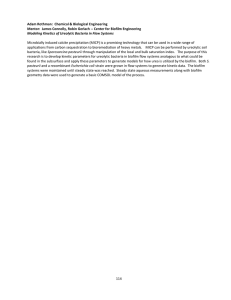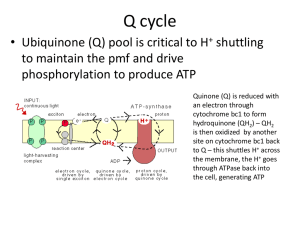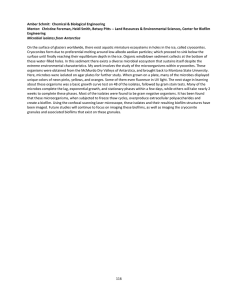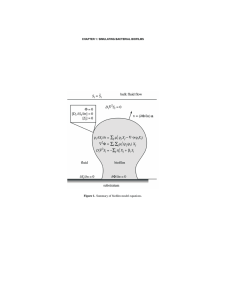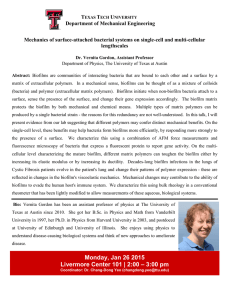article wjpr2015
advertisement
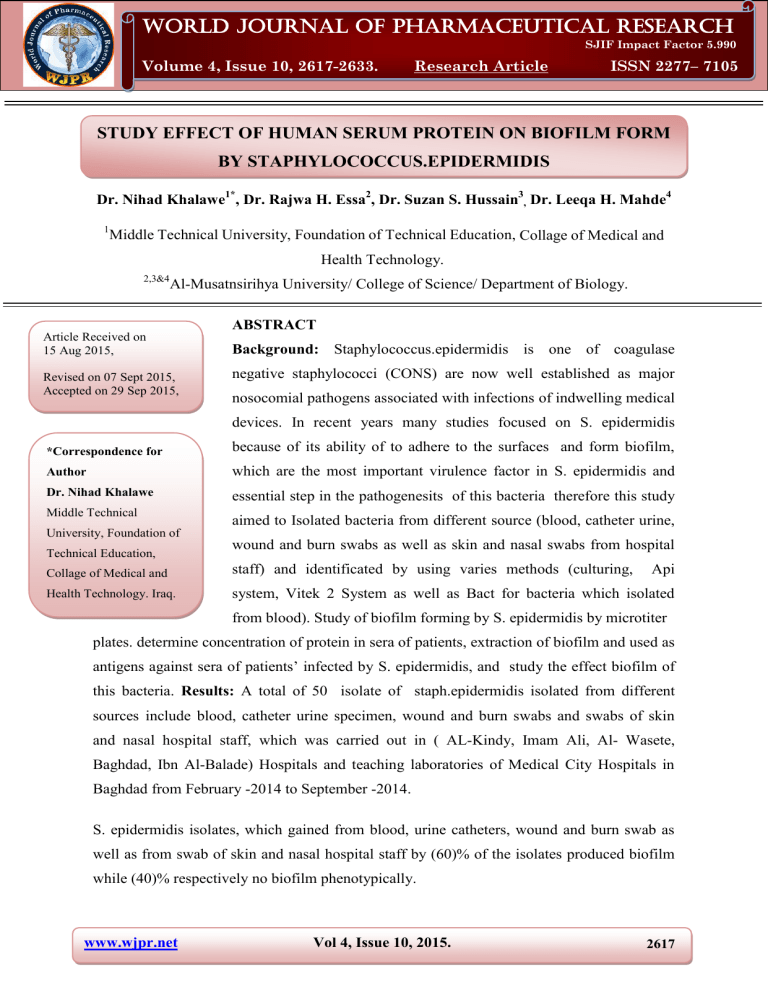
World Journal of Pharmaceutical Research Khalawe et al. World Journal of Pharmaceutical Research SJIF Impact Factor 5.990 Volume 4, Issue 10, 2617-2633. Research Article ISSN 2277– 7105 STUDY EFFECT OF HUMAN SERUM PROTEIN ON BIOFILM FORM BY STAPHYLOCOCCUS.EPIDERMIDIS Dr. Nihad Khalawe1*, Dr. Rajwa H. Essa2, Dr. Suzan S. Hussain3, Dr. Leeqa H. Mahde4 1 Middle Technical University, Foundation of Technical Education, Collage of Medical and Health Technology. 2,3&4 Al-Musatnsirihya University/ College of Science/ Department of Biology. Article Received on 15 Aug 2015, Revised on 07 Sept 2015, Accepted on 29 Sep 2015, ABSTRACT Background: Staphylococcus.epidermidis is one of coagulase negative staphylococci (CONS) are now well established as major nosocomial pathogens associated with infections of indwelling medical devices. In recent years many studies focused on S. epidermidis *Correspondence for because of its ability of to adhere to the surfaces and form biofilm, Author which are the most important virulence factor in S. epidermidis and Dr. Nihad Khalawe essential step in the pathogenesits of this bacteria therefore this study Middle Technical aimed to Isolated bacteria from different source (blood, catheter urine, University, Foundation of Technical Education, wound and burn swabs as well as skin and nasal swabs from hospital Collage of Medical and staff) and identificated by using varies methods (culturing, Api Health Technology. Iraq. system, Vitek 2 System as well as Bact for bacteria which isolated from blood). Study of biofilm forming by S. epidermidis by microtiter plates. determine concentration of protein in sera of patients, extraction of biofilm and used as antigens against sera of patients’ infected by S. epidermidis, and study the effect biofilm of this bacteria. Results: A total of 50 isolate of staph.epidermidis isolated from different sources include blood, catheter urine specimen, wound and burn swabs and swabs of skin and nasal hospital staff, which was carried out in ( AL-Kindy, Imam Ali, Al- Wasete, Baghdad, Ibn Al-Balade) Hospitals and teaching laboratories of Medical City Hospitals in Baghdad from February -2014 to September -2014. S. epidermidis isolates, which gained from blood, urine catheters, wound and burn swab as well as from swab of skin and nasal hospital staff by (60)% of the isolates produced biofilm while (40)% respectively no biofilm phenotypically. www.wjpr.net Vol 4, Issue 10, 2015. 2617 Khalawe et al. World Journal of Pharmaceutical Research Sera from patients with S. epidermidis infections showed reactivity with S. epidermidis antigens (whole cells) as: six of S. epidermidis antigens agglutinated in titer 1:2, 1: 4, 1: 32 and 1:128 of patients sera (antibodies) while 5,9 , 11 of S. epidermidis antigens agglutinated in the patients sera in titer (1:16, 1:64, 1:256) respectively, also concentration of sera protein (5.032) µg/ml gave 90% inhibition but concentration of sera protein (1.394) µg/ ml gave 30% inhibition. Conclusion: Sera from patients with S. epidermidis infections can reactivity with S. epidermidis antigens (whole cells), also concentration of sera protein (5.032) µg/ ml gave 90% inhibition but concentration of sera protein (1.394) µg/ ml gave 30% inhibition. KEYWORDS: S. epidermidis Coagulase Negative Staphylococci: CONS, antibodies, antigens. INTRODUCTION Staphylococci are common cause of nosocomial infection and biofilm is one of its important microbial virulence factors, formation of biofilm are development by bacteria has been suggested to be an important stage in the pathogenesis of numerous bacterial species by helps the bacteria to form stable communities of protection rather than live as free planktonic cells, establishment of biofilms by pathogenic bacteria on the tissues of susceptible hosts is believed to inhibit the effectiveness of antibiotic treatment, protect against host defense mechanisms, and bacterial communication leading to expression of virulence determinants [lachachi et al., 2013]. Biofilms are defined as the self-produced extra polymeric matrices that comprises of sessile microbial community where the cells are characterized by their attachment to either biotic or abiotic surfaces [Vasudevan, 2014]. Antibodies are defined as glycoprotein's (Immunoglobulin's), synthesized by lymph reticular system (b-cell) and released to the plasma and other body fluids [Roitt et al., 2002], Immunoglobulin's that react specifically with antigen produced Ab-Ag complex [Roitt et al., 2002], S. epidermidis had little susceptibility to phagocytic destruction by neutrophils, supposedly due to higher mechanical biofilm stability[Gunther etal., 2009], neutrophils form a physical barrier on the surface of biofilms, at these sites of neutrophil accumulation and frustrated phagocytosis, neutrophil intracellular contents such as AMPs, and proinflammatory www.wjpr.net Vol 4, Issue 10, 2015. 2618 Khalawe et al. World Journal of Pharmaceutical Research substances are often released, harming the superficial layers of the biofilm [Scott and Krauss, 2012], also S.epidermidis biofilms expressing poly-N-acetylglucosamine seem to be protected against opsonic phagocytosis and can reduce IGG and complement component C3b binding, allowing these bacteria to escape from neutrophil assault [Cerca, 2006; Kristian, 2008], so extra polymeric matrix is the first means of defense in favor of the pathogen and the presence of exopolysaccharide alginate protects the microbial cells from the phagocytosis [Percival et al., 2011]. Mature biofilm it can release antigens and stimulate production of antibodies, but bacteria which stay within the biofilm are resistant to these defense mechanisms also PNAG protects planktonic S. epidermidis bacteria against antibody independent phagocytosis, PNAG is enhanced by opsonization, that involves antibody and complement mediated phagocytosis [Kropec et al., 2005]. So the biofilm matrix can protecting bacteria from antibodies mediated phagocytosis in presence of antibodies opsonically active against the planktonic cells, by large amount of PNAG antigen present within matrix, when the minimizing antibodies binding to the bacterial cell surface, which it needs to promote opsonic killing as well as found more PNAG produced per cell within biofilm matrix, supporting conclusion that this large amount of antigen can inhibit antibody binding to the bacterial cell surface, While PNAG is protect planktonic bacteria against antibody-independent phagocytosis, it appear that even in presence of opsonic antibodies to PNAG and excess production of the target antigen within the biofilm which can preventing efficient opsonic killing [Lawrence et al., 2003]. METHODS Collection of samples A total of 50 isolate of staph. epidermidis isolated from different sources include blood, catheter urine specimen, wound and burn swabs and swabs of skin and nasal hospital staff, which was carried out in (AL-Kindy, Imam Ali, Al-Wasete, Baghdad, Ibn Al-Balade) Hospitals and teaching laboratories of Medical City Hospitals in Baghdad from February2014 to September -2014. Culturing of the samples Under aseptic conditions using standard bacteriological disposable plastic loop, 10 µl of uncetrifuged urine so, Swabs from skin and nasal from hospital staff and from burn or wound www.wjpr.net Vol 4, Issue 10, 2015. 2619 Khalawe et al. World Journal of Pharmaceutical Research infection were streaked on MacConkey and Blood agar plates and incubated at 37ºC for 24 hours, if no growth was detected, plates were re-incubated for another 24 hours before reported negative cultures as well as the blood which injected into blood culture bottles were incubated at 37°C in an automated blood culture system (Bactec 9120 system). Identification of Isolated Bacteria Macroscopic observations (Culture Characteristics) and Gram stains Colonial morphology of grown bacteria on culture media, Colony size, color, elevation, edges, hemolysis on blood agar and staining the isolated bacteria by gram stain (Fischbach, 2001). Vitek 2 system All CONS isolates were characterized using vitek 2 compact. The VITEK 2 is an automated microbial identification system. With its colorimetric reagent cards, and associated hardware and software advances, the VITEK 2 offers a state-of the art technology platform for phenotypic identification methods. Microscopic examination The isolates were stained by gram stain to detect their response to stain, shapes and their arrangement (Schleifer and Bell, 2009). Quantitation of biofilm by microtiter plate (M.t) In the present study, we screened the fifty clinical isolates of S.epidermidis for their ability to form biofilm by microtiter plate method according to the works of Christensen et al. (1985) with some modification Staph. epidermidis isolated from fresh agar plates were inoculated in in 3 ml of brain heart infusion (BHI) with 1% glucose (Mathur et al., 2006), broths incubated at 37ºC for 24 h. 1. Individual wells of sterile 96 well-flat bottom polystyrene tissue culture treated plates were filled with 200 µL of the diluted cultures and 200 μl aliquots of only BHI+1% glucose were dispensed into each of eight wells of the column 12 of microtiter plate to serve as a control (to check non-specific binding and sterility of media). 2. After incubation (24 h at 37°C), the microtiter plates content of each well was removed by tapping water or washed four times with 200 μL of phosphate buffer saline (1 × PBS pH 7.2) to remove planktonic bacteria. www.wjpr.net Vol 4, Issue 10, 2015. 2620 Khalawe et al. World Journal of Pharmaceutical Research 3. The plates were then inverted and blotted on paper towels and allowed to air dry for 15 min. 4. Adherent organisms forming biofilms in plate were fixed with sodium acetate (2%) and stained with crystal violet (0.1% w/v), and allowed to incubate at room temperature for 15 min. 5. After removing the crystal violet solution, wells were washed three times with 1 × PBS to remove unbound dye. 6. Finally, all wells were filled by 200 μl ethanol (95%) to release the dye from the cells and Optical density (OD) of stained adherent biofilm was obtained by using micro ELISA auto reader at wavelength 550 nm. 7. To correct background staining, the OD values of the eight control wells were averaged and subtracted from the mean OD value obtained for each strain. The experiment was repeated three times separately for each strain and the average values were calculated with standard deviation (SD), classified into the following categories: non-adherent (1) weakly (2), moderately (3), or strongly (4 ) adherent, based upon the ODs of bacterial films were classified as follows: OD ≤ ODc non–adherent, OD <OD ≤ 2ODc weakly, 2OD < OD ≤ 4ODc moderately, 4OD < OD strongly. Preparation Bacterial Antigen (Heat Killed Whomle Cell) [Agren etal., 1998] Heat killed whole cell bacterial antigen prepared as the following 1- Tube of 10 ml nutrient broth media were inoculated with 2-4 of a young bacterial isolates a n d incubated at 37oC for 24 hours. 2- Centrifuged culture at 4000rpm for 15min, then discarded the supernatant and washed the sediment three times in 5ml of phosphate buffer saline (PBS) by using centrifuge at (3500) rpm for five min after mixing by vortex. 3- Re-suspended the sediment in 5ml of PBS by vortex and put the suspension in water bath at 70oC for 1hour. 4- To make sure all bacteria was killed, cultured bacterial suspension on nutrient agar media at 37oC for 24 hour. 5- Centrifuged killed bacterial suspension at 4000rpm for five min then sediment was suspension in three ml of normal saline and used or stored in -20oC until use. www.wjpr.net Vol 4, Issue 10, 2015. 2621 Khalawe et al. World Journal of Pharmaceutical Research Production of antibodies Blood was collected from patients and serum was separated [Rehman et al., 2002]. 1. Collected blood and allowed it clot in an upright position for at least 30 minutes. 2. Centrifuge for 15 minutes at 1500 RPM. 3. Transfer the serum to a plastic screw-cap vial for transport to the laboratory and serum was stored (frozen at −20°C) until needed. Determine concentration of protein in sera of patients: by using Sp 3000 Nano System. Agglutination antigens with antibodies [Reaper et al., 2010] 1- Coating all wells by 50 µl (1.5 × 10 ^8 CFU/mL) of S. epidermidis antigen 2- Add serial dilutions of patient’s serum antibodies (1:2, 1:4, 1:8, 1:16, 1:32, 1:64, 1:128, 1:256) to all wells. 3- Recorded the macroscopically agglutination titers, also evaluated microscopically agglutination. all experiments were done in duplicate with 3 repeats. Effect of protein sera of pateints on biofilm formation [shahrooei, 2010] 1- The cultures diluted to an 0.005 at 600 nm were mixed with 10 µg/ml of sera of patients and incubated for 2 h at 4°C. 2- Add 200 µ l of the mixtures (106 cells) to each well o f 96-well polystyrene microtiter plates, t h e n incubated overnight at 37°C without shaking. 3- Washed the plates three times with PBS t h e n stained with 200 µl of 1% (wt/vol) crystal violet for 10 min, t h e n washed the plates 3 times with water and dried. 4- Added 1 6 0 µ l of 30% (vol/vol) acetic acid for quantification to each well to dissolve the stain. 5- Then Measured the dissolved stain at 595 nm by an automated ELISA microplate reader. 6- Percent inhibition of biofilm formation was calculated by using the following formula: Inhibition Percent of biofilm formation= (A595, positive-A595, antibody) / (A595, positive -A595, negative) × 100% (Sun et al. 2005). S. epidermidis in BHI without any added serum was used as positive control, and BHI without bacteria was used as negative control. Analysis of data Statistical analysis was performed by means of SPSS (statistical package for social sciences) 17.0 (SPSS Inc., Chicago, USA) software. Comparisons between groups were performed using the chi-square test. www.wjpr.net Vol 4, Issue 10, 2015. 2622 Khalawe et al. World Journal of Pharmaceutical Research RESULTS Table 1: Prevalence of Staph.epidermidis in the study groups STUDY GROUPS Blood culture Catheter urine specimen Wound and burns swab Swab of Skin and nasa Hospital staff Total NO. OF BACTERIAL ISOLATED 30 11 6 3 50 % 60 22 12 6 100 S.epidermidis is the most common cause of infections associated with catheters and other indwelling medical devices, these bacteria are most prevalent bacteria of the human skin and mucous membrane microflora, present unique problem in diagnosis and treatment infections involved biofilm formation. The results in table 1 showed blood samples occupied the first place in isolation of Staph. epidermidis froming 60%, followed by catheter urine in the second 22%, Wound and burns swab (12%) as well as (6%) from swab of Skin and nasal hospital staff. This is almost similar to the results of Mertens and Ghebremedhin (2013) whom showed that 75% of the S. epidermidis isolates from blood culture, While Donlan (2001) report found S.epidermidis is the most common cause of infections associated with catheters and other indwelling medical devices, these bacteria are most prevalent bacteria of the human skin and mucous membrane microflora, present unique problem in diagnosis and treatment infections involved biofilm formation. Mulu etal., (2012) showed in his study these organism i s a commensal or normal flora on the skin, several investigations have reported these organisms as common contaminants of wounds, and burns. Wound can contaminated by microorganisms that migrate from the urinary, respiratory and gastrointestinal tract [Bowler etal., 2001], this indicates the idea of autoinfection that burns patients suffer from in addition to the infection acquired from the burns unit itself [Collier, 2003]. As well as Gil et al., (2013) showed the biofilms produced by S. epidermidis strains are responsible for a number of nosocomial infections and infections on indwelling medical devices. www.wjpr.net Vol 4, Issue 10, 2015. 2623 Khalawe et al. World Journal of Pharmaceutical Research Table 2: Identification of Staphylococcus. epidermidis by API Staph system. Biochemical Test Negative control 0 Acidification of D-glucose GLU Acidification of D-fructose FRU Acidification of D-mannose MNE Acidification of D-maltose MAL Acidification of D-lactose LAC Acidification of D-trehalose TRE Acidification of D-mannitol MAN Acidification of xylitol XLT Acidification of D-melibiose MEL Reduction of nitrate to nitrite NIT Alkaline phosphatase PAL Acetyl-methyl-carbinol production VP Acidification of raffinose RAF Acidification of xylose XYL Acidification of sucrose SAC Acidification of α-methyl-D-glucoside Acidification of N-acetyl glucoseamine MDG Arginine dihydrolase ADH NAG Urease URE Resul ts + + + + + + + + + - Note: Staphylococcus epidermidis profile number (6706113) Figure 1: code for Staphylococcus epidermis (6706113) by API staph system. API Staph System test is essential for accurate diagnosis of the bacterial isolates in this study as well as the comparison method described up, In current study, it appeared S.epidermidis was (68.5%), these results confirm that the commercial identification kits are only of limited value in identifying CONS isolates, as reported previously [Couto etal.,2001], but cunha etal., (2004) result showed Inaccurate identification by the API Staph method, while Couto, etal (2001) explained in study according to the API Staph System, 7 of the isolates were www.wjpr.net Vol 4, Issue 10, 2015. 2624 Khalawe et al. World Journal of Pharmaceutical Research characterized as S. aureus, 10 as S. xylosus, 2 as S. epidermidis, 3 as S. warneri, 8 as S. cohnii a nd 4 as S. lentus ,however, 6 isolates could not be identified. API Staph System are rapid biochemical tests, also faster and less laborious than classical biochemical characterization, but t a k e at least 24 h for appropriate results [Pascoli etal., 1986], most isolates tested were identified by API Staph only to the genus level, because the results of the 20 biochemical reactions were often identical for different staphylococcal species, a variation in a single reaction could also cause a misidentification, In addition, tests such as reduction of nitrate to nitrite, alkaline phosphatase and acetyl-methyl-carbinol production (Voges–Proskauer reaction) were difficult to interpret [Couto et al., 2001]. Automicrobic VITEK system may represent a useful method for rapid identification in coagulase-negative staphylococci [ Venditti et al., 1991]. Detection of slime-production by S. epidermidis isolates C- MTP method Strong produced biofilm Moderate produced biofilm Weak /non produced biofilm Figure 2: (a) Biofilm producer and no producer on tissue culture plate method. Ability of S. epidermidis to form slime can be inferred by phenotypic characteristic The results obtained in this study show that the degree of biofilm production is high in the examined isolates of S. epidermidis. The 60% of examined strains were biofilm producers, while 40% of thes strains were not biofilm producers. Among biofilm producers, the majority of isolates (39.26%) were strong biofilm producers. www.wjpr.net Vol 4, Issue 10, 2015. 2625 Khalawe et al. World Journal of Pharmaceutical Research Table 3: Biofilm produced by microtiter plate method according to Source of S.epidermidis. NO.NONNO. BIOFILM OF PRODUCED BIOFILM (%) PRODUCER (%) Blood 30 12(40) 18(60) Catheter urine 11 5 (45.5) 6(54.5) Wound and burns swab 6 1 (16.7) 5(83.3) Swab of skin and nasal hospital staff 3 2(66.7) 1(33.3) Total No.(%) 50(68.6) 20(40) 30(60) Biofilm production was determined by the Microtiter plate method. SOURCE OF STAPH .EPIDERMIDIS NO.OF ISOLA TE PHENOTYPE METHODS USED (M.T.P) 18 6 5 1 30(60) Table 3 showed (60%), of S. epidermidis isolates, which were gained from blood by (54.5 %) of the isolates from urine catheters, wound and burns swab produced biofilm phenotypically by 83.3% also 33.3% from swab of skin and nasal hospital staff, while (40, 45.5, 16.7) % respectively of the S. epidermidis isolates from blood culture, urine catheters and wound and burns swab as well as (66.7%) from swab of skin and nasal hospital staff produced no biofilm phenotypically. biofilm production is considered to be less in case of samples collected from healthy skin when compared to those collected from people associated with infections [Arciola et al., 2001]. As study reported that 44.2% of the samples that were collected from patients were strong biofilm-producers compared to 0% of the samples that were isolated from healthy volunteers [Mateo etal., 2007]. Ansari et al., (2015) showed (80%) isolates of S. epidermidis ability to produce black colonies, which are indicative of biofilm formation by CRA methods , while Gamal etal., (2009), showed 88.6%of S. epidermidis were biofilm producers, as the results of Arslan and Ozkarde(2007) explained that CRA method demonstrated positive results in 38.5% of staphylococci isolated from clinical specimens. Antigen - Antibodies titration Agglutination are based on the presence of antibodies in patient sera that can react with specific antigens and form visible clumps, but formation of biofilm may protect bacteria from the action of antibodies [Pourmand etal., 2006]. www.wjpr.net Vol 4, Issue 10, 2015. 2626 Khalawe et al. World Journal of Pharmaceutical Research 1 control 2control 3control Figure 3: Antigen - Antibodies titration with control (control 1: Only BHI broth Control 2: BHI + Bacteria Control 3: BHI + Serum) In figure 3 apparent the positive reaction between surface antigens of bacteria and the antibodies, which consider as a good tool used for diagnose infection and identify bacterial isolates by detection of bacterial-specific antibodies in samples. Table 4: agglutination of antigens (whole cells of S. epidermidis which formed Biofilm) against antibodies in sera of patients. CONCENTRATION OF S.EPIDERMIDIS ANTIGENS(WHOLE CELLS) NO.OF PATIENT TITER OF ANTIBODIES CONTROL (SERUM ) 6 6 1 5 6 9 6 11 2 4 8 16 32 64 128 256 0 (1.5×10^8 CFU/mL) Results in table 4 showed sera from patients reactivity with S. epidermidis antigens (whole cells) as: six of S. epidermidis antigens agglutinated in titer 1:2, 1:4, 1:32 and 1:128 of patients sera (antibodies) while 5,9,11 of S. epidermidis antigens agglutinated in the patients sera in titer (1:16, 1:64, 1:256) respectively. Most S. epidermidis have a pronounced ability to bind non-specifically to naked polymer surface, this binding can be blocked by coating the surface with various proteins, as fibrinogen (fg), extract of S. epidermidis may be useful in serodiagnosis of coagulasenegative staphylococcal,however, in this table appearance one only of S. epidermidis antigens www.wjpr.net Vol 4, Issue 10, 2015. 2627 Khalawe et al. World Journal of Pharmaceutical Research positive agglutinated in titer 1:8, High level of antibodies may inhibition the agglutination reaction [Frank etal., 2007]. Results of Pourmand etal., (2006) study explained the higher titers of antibodies to several proteins were observed in individuals who were not nasal carriers of S.aureus than in sera patients who were carriers these bacteria, surface proteins of Staphylococci have led to development of several potentially immunological therapeutic and prophylactic strategies for control of this organism [Flock, 1999], a high anti-IGG titer in donor serum have potential to reduce sepsis caused by S. aureus and mortality in infants [Bloom etal., 2010], An antibody response to a given antigen is indicative of its expression in vivo and of its potential for use in a subunit vaccine or as a target in passive immunotherapy or prophylaxis [Pourmand etal., 2006], So some of antigenic S. epidermidis proteins are potential targets for immunotherapy, which provides a novel strategy for control of S. epidermidis infection, and could potentially reduce infection and have a significant impact on human health. Interestingly, a subset of S. epidermidis proteins a r e also conserved in S. aureus and in other genera. These antigens may have important functions in disease [Clarke etal., 2006]. Results of Kumar etal., (2005) study showed elevated levels of IGG to teichoic acid antigen were detected in all (100%) group patients while 40% with superficial infection, so (72%) of IgG antibodies to peptidoglycan and (60%) patients with superficial staphylococcal infection. An increase in levels of antibodies to peptidoglycan showed a positive correlation trend with levels of IgG antibodies to teichoic acid only in deep infection group. Table 5: Percent Inhibition of concentration sera protein on biofilm formation CONCENTRATION NO. OF Percent Inhibition OF SERA PROTEIN PATEINTS of biofilm formation (%) ( µG/ML) SERA 1.394 13 30 2.156 13 62 3.007 7 79 4.429 12 82 5.032 5 90 Total 50 Results in table 5 showed Effect of concentration sera protein (antibodies) on biofilm formation, the concentration of sera protein (5.032) µg/ ml gave90% inhibition in five sera of patients but concentration of sera protein (1.394) µg/ ml gave 30% inhibition thirty sera of patients. McCool etal., (2002) identified a serum immunoglobulin G (IgG) and secretory www.wjpr.net Vol 4, Issue 10, 2015. 2628 Khalawe et al. World Journal of Pharmaceutical Research IgA response to pneumococcal surface protein A as a result of colonization; individuals who did not become colonized after inoculation had preexisting antibodies to this protein, in sessile cells, SesC are a surface-exposed protein of which the expression is slightly higher compared to their planktonic SesC is a promising antigen for vaccination against S.epidermidis biofilm formation and production of protective antibodies against S.epidermidis established biofilms [Shahrooei etal.,2009], Shahrooei (2010) study showed the polyclonal antibodies cross react with other non-specific antigens, the concentration of antibodies which was used not sufficient for inhibition of the function of some Ses proteins. Specific antibodies blocked biofilm development at the initial attachment and aggregation stages, and deletion or inhibited normal biofilm formation. So specific antibodies also serve as opsonins to enhance neutrophil binding, motility, and biofilm engulfment, Vaccination against, or therapeutic antibodies reactive to proteins may provide targets for use against a broad spectrum of gram-positive bacteria [Shahrooei, 2012]. Results may explained by Shahrooei (2012) who proved a SesC inhibited S. epidermidis biofilm formation in a rat model of subcutaneous foreign body infection. CONCLUSIONS We can conclude from our study that 1. Extracted biofilm used as antigens against sera of patients’ infected. 2. Sera from patients with S. epidermidis infections can reactivity with S. epidermidis antigens (whole cells), also concentration of sera protein (5.032) µg/ ml gave 90% inhibition but concentration of sera protein (1.394) µg/ ml gave 30% inhibition. REFERENCE 1. Ansari, M.A.; Khan, H.M.; Alzohairy, M.A. Anti-biofilm efficacy of silver nanoparticles against MRSA and MRSE isolated from wounds in a tertiary care hospital, 2015; 33(1): 101-109. 2. Arslan, S.; Ozkardes, F. Slime production and antibiotic susceptibility in staphylococci isolated from clinical samples. Memorias do Instituto Oswaldo Cruz, 2007; 102(1):29-33. 3. Arciola, C.R., Baldassarri, L., and Montanaro, L. Presence of icaA and icaD genes and slime production in a collection of staphylococcal strains from catheter-associated infections. J Clin Microbiol, 2001; 39: 2151–2156. www.wjpr.net Vol 4, Issue 10, 2015. 2629 Khalawe et al. World Journal of Pharmaceutical Research 4. Agren, K.; Brauner, A. and Anderson. J. Haemophilus influenza and Streptococcus pyogenes group a challange induce the Thl type ofcytokine of response in cells obtained from tonsillar hypertrophy and recurrent tonsillitis. OLR. 1998, 60: 35-41. 5. Barraud, N.; Hassett, D.J.; Hwang, S.; Rice, R.A. Involvement of nitric oxide in biofilm dispersal of Pseudomonas aeruginosa. Journal of Bacteriology, 2006; 188(21): 73447353. 6. Bloom, B.; Schelonka, R.; T. Kueser; W. Walker; E. Jung; D. Kaufman; K. 7. Bowler, P.G.; Duerden, B.I.; and Armstrong, D.G. Wound microbiology andassociated approaches to wound management. Clin. Microbial. Rev, 2001; 14(2); 244-269. 8. Brumatti, G.; Salmanidis, M; and Ekert, P.G. Crossing paths: interactions between the cell death machinery and growth factor survival signals. Cell Mol Life Sci, 2010; 67(10): 1619–1630. 9. Cerca, N.; Jefferson, K.K.; Oliveira, R.; Pier, G.B.; Azeredo, J. Comparative antibodymediated phagocytosis of Staphylococcus epidermidis cells grown in a biofilm or in the planktonic state. Infect Immun, 2006; 74: 4849–55. 10. Clarke, S. R. and Foster, S. J. Surface adhesins of Staphylococcus aureus. Adv Microb Physiol, 2006; 51, 187–224. 11. Collier, M. (2003).Understanding wound inflammation. Nurs. Times. 99 (25). 12. Couto,I.;Pereira,S.;Miragaia,M.;Sanches,I.S.;delencastre, Identification of clinical staphylococcal isolates from humans by internal transcribed spacer PCR. J Clin Microbiol, 2001; 39: 3099–3103. 13. Cunha, M. L.; Rugolo, L.M.; Lopes, C.A. Study of virulence factors in coagulasenegative staphylococci isolated from newborns. memInst Oswaldo Cruz, 2006; 101(6):661-8. 14. Donlan, R. M. Biofilm formation: a clinically relevant microbiological process. Clin. Infect. Dis, 2001; 33: 1387-1392. 15. Flock, J.-I. Extracellular-matrix-binding proteins as targets for the prevention of Staphylococcus aureus infections. Mol. Med. Today, 1999; 5: 532–537. 16. Frank, K.L.; Reichert, E.J.; Piper, K.E.; Patel, R. In vitro effects of antimicrobial agents on planktonic and biofilm forms of Staphylococcus lugdunensis clinical isolates. Antimicrob. Agents Chemother, 2007; 51: 888–895. 17. Gil, C.; Solano, C.; Burgui, S.; Latasa, C.; García, B.; Toledo-Arana, A.; Lasa, I. and Valle, J. Biofilm matrix exoproteins induce a protective immune response against Staphylococcus aureus biofilm infection.Infect Immun, 2014; 82(3): 1017-29 www.wjpr.net Vol 4, Issue 10, 2015. 2630 Khalawe et al. World Journal of Pharmaceutical Research 18. Gamal Fadl Gad, Mohamad Ali EL Feky, Mostafa Saied EL-Rehewy, Mona Amin Hassan, Hassan Aboelella and Rehab Mahmoud Abd EL Baky. Detection of icaA, icaD genes and biofilm production by Staphylocococcus aureus and Staphylococcus epidermidis isolated from urinary tract catheterized patients, J. Infect. Dev. Ctries, 2009; 3(5): 342-351. 19. Günther, F.; Wabnitz, G.H.; Stroh, P. Host defence against Staphylococcus aureus biofilms infection: Phagocytosis of biofilms by polymorphonuclear neutrophils (PMN). Molecular Immunology, 2009; 46(8-9): 1805-1813. 20. Kristian, S.A.; Birkenstock, T.A.; Sauder, U. Biofilm formation induces C3a release and protects Staphylococcus epidermidis from IgG and complement deposition and from neutro- phil-dependent killing. Infect Dis, 2008; 1197(7):1028-35. 21. Kropec, A.; T. Maira-Litrán, K. K.; Jefferson, M.; Grout, S. E.; Cramton, F. Götz; D.A. Goldmann.; and G.B. Pier. Poly-N-acetylglucosamine production in Staphylococcus aureus is essential for virulence in murine models of systemic infection. Infect. Immun, 2005; 73: 6868-6876. 22. Kumar ;Ashok; Pallab Ray; Mamta Kanwar; Meera Sharma;and Subhash Varma.(2005). A comparative analysis of antibody repertoire against Staphylococcus aureus antigens in Patients with Deep-Seated versus Superficial staphylococcal Infections.Int J Med Sci; 2(4):129-136. 23. Lachachi;Meriem; Hafida Hassaine; Kaotar Nayme; Samia Bellifa; Imene M’hamedi; Ibtissem Kara Terki and Mohammed Timinouni. Detection of biofilm formation; icaADBC gene and investigation of toxin genes in Staphylococus spp. strain from dental unit waterlines; University Hospital Center (UHC) Tlemcen Algeria;academic journal, 2013; 8(6): 559-565 . 24. Lawrence, J. R.; G. D. W. Swerhone; G. G. Leppard; T. Araki; X. Zhang; M. M. West; and A. P. Hitchcock. Scanning transmission X-ray; laser scanning; and transmission electron microscopy mapping of the exopolymeric matrix of microbial biofilms. Appl. Environ. Microbiol, 2003; 69: 5543-5554. 25. Mateo, M.; Maestre, J.R.; Aguilar, L.; Giménez, M.J.; Granizo, J.J.; Prieto, J.(2007). Strong slime production is a marker of clinical significance in Staphylococcus epidermidis isolated from intravascular catheters. Eur J Clin Microbiol Infect Dis, 2003; 27: 311-4. 26. McCool, T.L.; Cate, T.R.; Moy, G.; Weiser, J.N. The immune response to pneumococcal proteins during experimental human carriage. J Exp Med, 2002; 195: 359–65. www.wjpr.net Vol 4, Issue 10, 2015. 2631 Khalawe et al. World Journal of Pharmaceutical Research 27. Mertens and B. Ghebremedhin. Genetic determinetic and bioofilm formation of clinical Staphylococcus epidermidis isolates from blood culture and indwelling devises. European Journal of Microbiology and Immunologym, 2013; 3(2): 111–119. 28. Mulu, W.; Kibru, G.; Beyene, G.; Damtie, M. Postoperative nosocomial infections and antimicrobial resistance pattern of bacteria isolates among patients admitted at Felege Hiwot Referral Hospital; Bahirdar. Ethiopia Ethiop J Health Sci, 2012; 22(1): 7–18. 29. Pascoli, L.; Chiaradia, V.; Mucignat, G. and Santani, G. Identifcation of Staphylococci by the API STAPH; Sceptor; Rosco and Simpli®ed Lyogroup Systems. European Journal of Clinical Microbiology, 1986; 5: 669-671. 30. Percival, S.L.; Malic, S.; Cruz, H.; Williams, D.W.(2011). Introduction to biofilms. Biofilms and Veterinary Medicine 6: 41-68. 31. Pourmand; Mohammad, R.; Simon, R. Clarke; Richard, F. Schuman; James, J. Mond; and Simon, J. Foster. Identification of Antigenic Components of Staphylococcus epidermidisExpressed during Human Infection. Inf. & immune, 2006; 74(8): 4644–4654. 32. Reaper Jacqueline; Sally Ann Collins; John McMullan; Roger Bayston. The use of ASET (Anti Staph Epidermidis Titer) in the diagnosis of ventriculoatrial shunt infection; Cerebrospinal Fluid Research; Academic Journal, 2010; 7: 1. 33. Rehman, K.; M.A. Zia; M. Arshad; T. Mehmood and S. Hamid, Conjugation of peroxidase with antibodies against haemorrhagic septicaemia. Int. J. Agri. Biol, 2002; 4: 78–80. 34. Roitt, I.; Brostoff, J.and Male, D. Immunology. 6th ed. Mosby; Spain, 2002; p. 119-129. 35. Schleifer, K.H.; Bell, J.A. Genus I. Staphylococcus Rosenbach 1884; 18AL (Nom. Cons. Opin. 17 Jud. Comm. 1958; 153.); in: De Vos; P.; Garrity; G.M.; Jones; D.; Krieg; and N.R.; Ludwig; W.; Rainey; F.A.; Schleifer; K.H.; Whitman; and W.B. (Eds.); Bergey’s Manual of Systematic Bacteriology; The Firmicutes, 2009; (3): 392–421. 36. Scott, D.A.and Krauss, J. Neutrophils in periodontal inflammation. Front Oral Biol, 2012; 15: 56–83. 37. Shahrooei, M.; Vishal Hira; Laleh Khodaparast; Ladan Khodaparast; Benoit Stijlemans; Soňa Kucharíková; Peter Burghout; Peter, W. M. Hermans and-Johan Van Eldere. Vaccination with SesC Decreases Staphylococcus epidermidis Biofilm Formation. Infect. Immun, 2012; 80(10): 60-68. 38. Shahrooei, Mohammad. (2010). Identification of potential targets for vaccination against staphylococcus epidermidis biofilm; phd. Medical Sciences.Leuven; Katholieke www.wjpr.net Vol 4, Issue 10, 2015. 2632 Khalawe et al. World Journal of Pharmaceutical Research Universiteit Leuven Group Biomedical Sciences;Faculty of Medicine; Department of Medical Diagnostic Sciences. 39. Shahrooei, Mohammad; Vishal Hira; Rita Merckx; Benoit Stijlmans; Peter, W.M. Hermans; Johan Van Eldere. Inhibition of Staphylococcus epidermidis biofilm formation by rabbit polyclonal antibodies against SesC protein. Infection and Immunity. 2009; 77(9): 3670-3678. 40. Vasudevan; Ranganathan. Biofilms: Microbial Cities of Scientific Significance. J Microbiol Exp, 2014; 1(3). 41. Venditti, M.; S. Santilli; P. Petasecca Donati; A. Micozzi. Species Identification and Detection of Oxacillin Resistance in Coagulase-Negative Staphylococcus Blood Isolates from Neutropenic Patients .European Journal of Epidemiology, 1991; 7(6): 686-689. www.wjpr.net Vol 4, Issue 10, 2015. 2633
